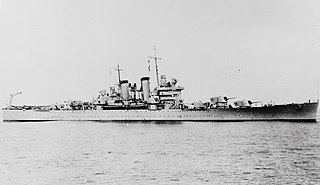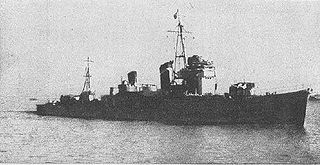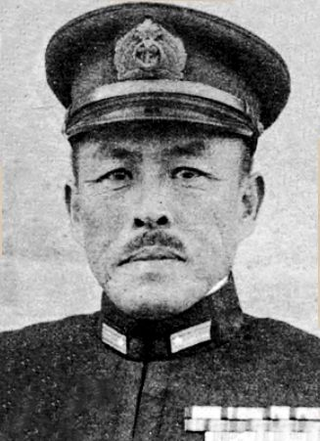
USS Radford (DD-446), named for Rear Admiral William Radford, was a Fletcher-class destroyer in the United States Navy. Entering service in 1942 during World War II the ship also saw action during the Korean War and the Vietnam War. The ship was removed from service in 1969 and sold for scrap in 1970.

The Battle of Kolombangara was a naval battle of the Pacific campaign of World War II, fought on the night of 12/13 July 1943, off the northeastern coast of Kolombangara in the Solomon Islands. The battle took place during the early stages of the New Georgia campaign when an Imperial Japanese Navy force, carrying reinforcements south to Vila, Solomon Islands, was intercepted by a task force of U.S. and New Zealand light cruisers and destroyers. In the ensuing action, the Japanese sank one Allied destroyer and damaged three cruisers. They were also able to successfully land 1,200 ground troops on the western coast of Kolombangara but lost one light cruiser sunk in the process.

The Battle of Kula Gulf took place in the early hours of 6 July 1943 during World War II. The battle involved United States and Japanese ships off the eastern coast of Kolombangara in the Solomon Islands. It took place during the early stages of the New Georgia campaign when a Japanese force landing reinforcements at Vila was intercepted by a force of US Navy cruisers and destroyers. One US light cruiser was sunk during the engagement while two Japanese destroyers were sunk and two more were damaged. The Japanese withdrew after the engagement, having landed 1,600 troops.

USS Helena was a Brooklyn-class light cruiser built for the United States Navy in the late 1930s, the ninth and final member of the class. The Brooklyns were the first modern light cruisers built by the US Navy under the limitations of the London Naval Treaty, and they were intended to counter the Japanese Mogami class; as such, they carried a battery of fifteen 6-inch (150 mm) guns, the same gun armament carried by the Mogamis. Helena and her sister St. Louis were built to a slightly modified design with a unit system of machinery and an improved anti-aircraft battery. Completed in 1939, Helena spent the first two years of her career in peacetime training that accelerated as tensions between the United States and Japan increased through 1941. She was torpedoed at the attack on Pearl Harbor in December 1941 and was repaired and modernized in early 1942.

USS Honolulu (CL-48) of the United States Navy was a Brooklyn-class light cruiser active in the Pacific War. Honolulu was launched in 1937 and commissioned in 1938. The ship served in the Battle of Tassafaronga, the Battle of Kula Gulf, the Battle of Kolombangara and the Battle of Peleliu. She was taken out of action by serious torpedo damage just before the Battle of Leyte Gulf. She was repaired, but not in time to rejoin the war. She was decommissioned in 1947 and was held in reserve until she was scrapped in 1959.

USS Denver (CL-58) was a Cleveland-class light cruiser. Denver launched on 4 April 1942 by New York Shipbuilding Corp., Camden, New Jersey; sponsored by Miss L. J. Stapleton, daughter of the Mayor of Denver; and commissioned on 15 October 1942, Captain Robert Carney in command. It was the second ship named for the city of Denver, Colorado.

The Battle of Vella Gulf was a naval battle of the Pacific campaign of World War II fought on the night of 6–7 August 1943 in Vella Gulf between Vella Lavella and Kolombangara in the Solomon Islands of the southwest Pacific.

The Battle of Blackett Strait was a naval battle of the Pacific campaign of World War II, fought on 6 March 1943 in the Blackett Strait, between Kolombangara and Arundel Island in the Solomon Islands. The battle was a chance encounter between two Japanese destroyers that had been undertaking a resupply run to Vila and a U.S. Navy force of three light cruisers and three destroyers that had been tasked with bombarding the Japanese shore facilities around Vila. The two forces clashed as the Japanese destroyers were withdrawing through the Kula Gulf. In the short battle that followed the two Japanese destroyers were sunk, after which the U.S. ships completed their bombardment of Vila before returning to their base.

The New Georgia campaign was a series of land and naval battles of the Pacific Theater of World War II between Allied forces and the Empire of Japan. It was part of Operation Cartwheel, the Allied strategy in the South Pacific to isolate the Japanese base around Rabaul. The campaign took place in the New Georgia Islands in the central Solomon Islands and followed the Allied capture of the Russell Islands. The main fighting took place on New Georgia itself, although significant actions also took place around the island chain throughout the campaign.

USS Nicholas (DD/DDE-449) was a Fletcher-class destroyer of the United States Navy, serving for a total of 27 years, including through most of World War II, the Korean War, and the Vietnam War. She was the second Navy ship to be named for Major Samuel Nicholas.

USS O'Bannon (DD/DDE-450), a Fletcher-class destroyer, was the second ship of the United States Navy to be named after Lieutenant Presley O'Bannon (1784–1850), the Marine Corps's "hero of Derna".

USS Chevalier (DD-451), a Fletcher-class destroyer, was the first ship of the United States Navy to be named for Lieutenant Commander Godfrey Chevalier.

USS Gwin (DD-433), a Gleaves-class destroyer, was the third ship of the United States Navy to be named for Lieutenant Commander William Gwin, an American Civil War officer who commanded river boats against Confederate forces in Alabama.
Murasame was the third of ten Shiratsuyu-class destroyers, and was built for the Imperial Japanese Navy under the "Circle One" Program. This vessel should not be confused with the earlier Russo-Japanese War-period Harusame-class torpedo boat destroyer with the same name.

Kawakaze was the ninth of ten Shiratsuyu-class destroyers, and the third to be built for the Imperial Japanese Navy under the Circle Two Program. Completed in April of 1937, Kawakaze saw minor roles in the battles of the Java Sea, Eastern Solomans, Santa Cruz, and Guadalcanal, usually not doing much of note, but torpedoed and sank the destroyer USS Blue in the aftermath of the Battle of Savo Island, and came to her own in the Battle of Tassafaronga where she torpedoed and sank the heavy cruiser USS Northampton. Kawakaze was sunk by a mass torpedo attack from US destroyers at the Battle of Vella Gulf.

Suzukaze was the tenth and final vessel of ten Shiratsuyu-class destroyers, and the fourth to be built for the Imperial Japanese Navy under the Circle Two Program.

Jintsū (神通) was the second vessel completed in the three-ship Sendai-class light cruiser in the Imperial Japanese Navy (IJN), named after the Jinzū River in the Gifu and Toyama prefectures of central Japan. She was active in World War II in various campaigns including the Japanese invasion of the Philippines, the Battle of the Java Sea, and Battle of Midway. On 13 July 1943 in the Battle of Kolombangara, she was discovered during a night attack by American ships and sunk in combat.

Teruo Akiyama was an admiral in the Imperial Japanese Navy during World War II.

The Battle of Vella Lavella was a naval battle of the Pacific campaign of World War II fought on the night of 6 October 1943, near the island of Vella Lavella in the Solomon Islands. It marked the end of a three-month fight to capture the central Solomon Islands, as part of the Solomon Islands campaign.

Robert Ward Hayler was a highly decorated officer in the United States Navy with the rank of vice admiral. He was a three time recipient of the Navy Cross, the Navy's second highest military decoration for valor. Two of these awards were received while serving as the commanding officer of the light cruiser USS Honolulu at Guadalcanal and Kula Gulf and the third as a rear admiral and Commander, Cruiser Division Twelve during the Battle of Surigao Strait in October 1944.




















